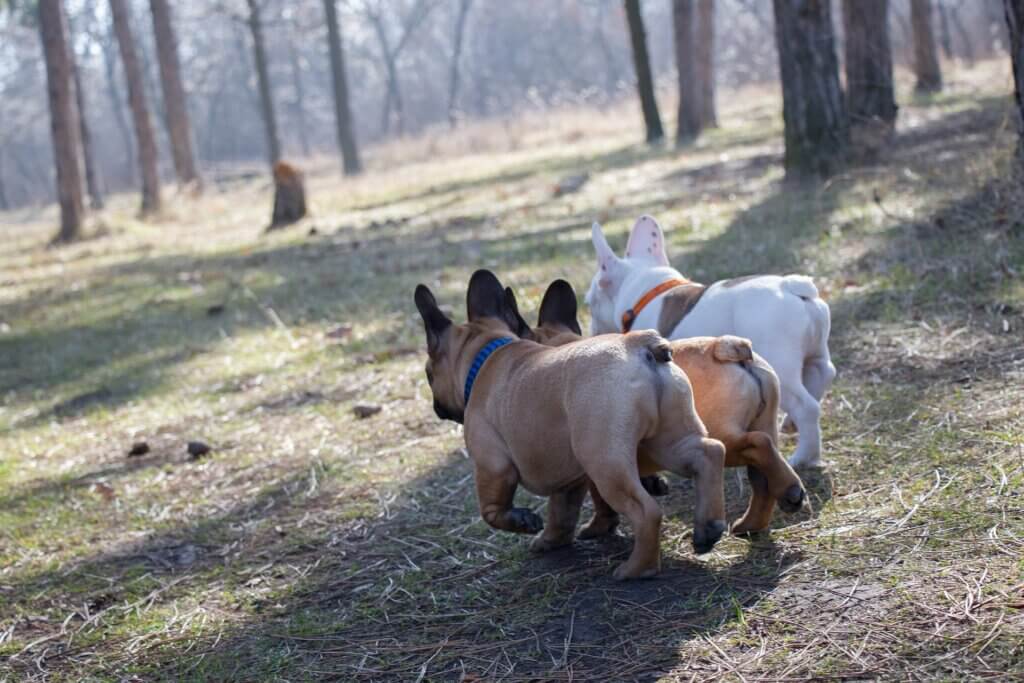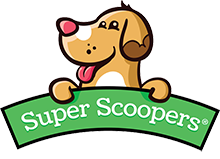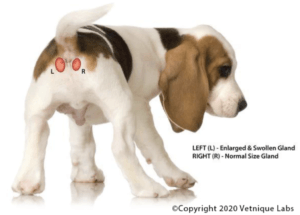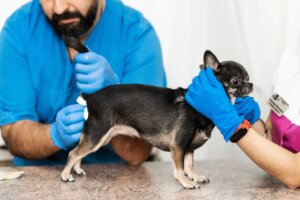What’s That Smell? How to Deal with Dog Anal Gland Problems.

Have you noticed a stinky, fishy odor coming from your dog? You may be dealing with dog anal gland problems. This smelly problem is rather common, but that doesn’t make it any more pleasant. It isn’t comfortable to talk about but it is a necessary conversation for dog owners, especially those with small dogs or obese dogs. It’s gross, but then again, we specialize in scooping dog poop, so we’re prepared to go there.
What Are Dog Anal Glands?
Dogs have two sacs on both sides of the anus. These sacs (aka anal glands) produce a unique odor to mark the dog’s territory. VCA Hospitals explains, “The anal sac secretion contains chemicals that act as territorial markers or ‘dog calling cards’. The secretions are similar to those produced by a skunk, which is used to repel enemies and alert other animals to their presence.”
What Is Anal Sac Disease?
The anal gland secretions are usually expelled when a dog has a bowel movement. However, these anal sacs can be impacted, which causes inflammation. Moreover, bacteria usually found in feces can enter the sacs, which leads to infection. Anal sac disease includes several different anal gland-related conditions, including anal gland impaction, anal gland infection, ruptured anal gland abscess, and anal gland cancer.
Signs of Dog Anal Gland Problems
Besides the foul odor, there are other signs your dog may be suffering from anal gland issues.
If you notice your dog doing any of the following, contact your veterinarian.
- Scooting
- Frequently turning to lick or bite their bottom
- Straining to poop
- Showing discomfort when pooping
- Not wanting to sit
- Anal discharge
- Blood or pus in the stool or near the anus
Common Causes of Dog Anal Gland Problems
Anal gland issues tend to be more common in smaller breeds, such as miniature poodles or chihuahuas, but they can occur in larger dogs, as well.
Here are other causes:
- Chronic skin conditions
- Obesity (Pure Pet Food explains, “Fatty tissue around the glands and a lack of muscle tone means the glands may not empty properly.”)
- Inadequate dietary fiber
- Change in stool consistency
- Parasites
- Food and/or environmental allergies
- Genetics
Treatments for Dog Anal Gland Problems
If you notice your dog displaying any of the common signs of anal gland issues, make an appointment with your veterinarian. A veterinarian will likely express the sacs (which means emptying the anal glands). If the veterinarian suspects there is an infection, he or she may suggest an antibiotic.
Your veterinarian may also recommend an anal gland supplement, as well as a diet plan. You may find adding fish oil and dietary fiber to your dog’s diet makes a difference.
How to Express Anal Glands
Here are step-by-step instructions from PetMD:
- If your dog is small, place them on a table or counter in front of you. If you have a large dog, you can kneel behind them.
- Have another person hold your dog by placing one arm underneath and around their neck, and the other arm around the rest of your dog’s body, hugging them close.
- Put on a pair of latex or similar gloves and lubricate your index finger with petroleum jelly or a water-based lubricant.
- Lift up your dog’s tail and gently insert your index finger into the rectum approximately 1 inch.
- Feel with your index finger and thumb for a firm pea- or marble-sized object at the 5 or 7 o’clock positions.
- When you have found one gland, place a paper towel between the dog’s anus and your hand and gently milk the gland’s contents outward by applying pressure on the farthest side of the gland and squeezing toward you. Do not use more pressure than you would feel comfortable applying if you were pressing on your eyes, for example.
- You should barely be able to feel the gland when it’s empty.
- Wipe the anal area clean.
- Repeat on the other side for the other gland.
Important Notes: If you choose to express your dog’s anal glands at home, you should wear gloves and use petroleum or another water-based lubricant. Be on the lookout for issues that may require seeking assistance from a veterinarian, such as your dog appearing in pain as you express the anal glands or bloody material. You should also have something on hand for cleanups, such as waterless shampoo or butt deodorizer.
If you want to see a video for a tutorial on how to express your dog’s anal glands, see this webpage from Glandex (an anal gland supplement). Be warned that it is graphic and not for the squeamish.
If you are dealing with a stinky yard deal to piles of dog poop, schedule regular pooper scooper service from Super Scoopers!




